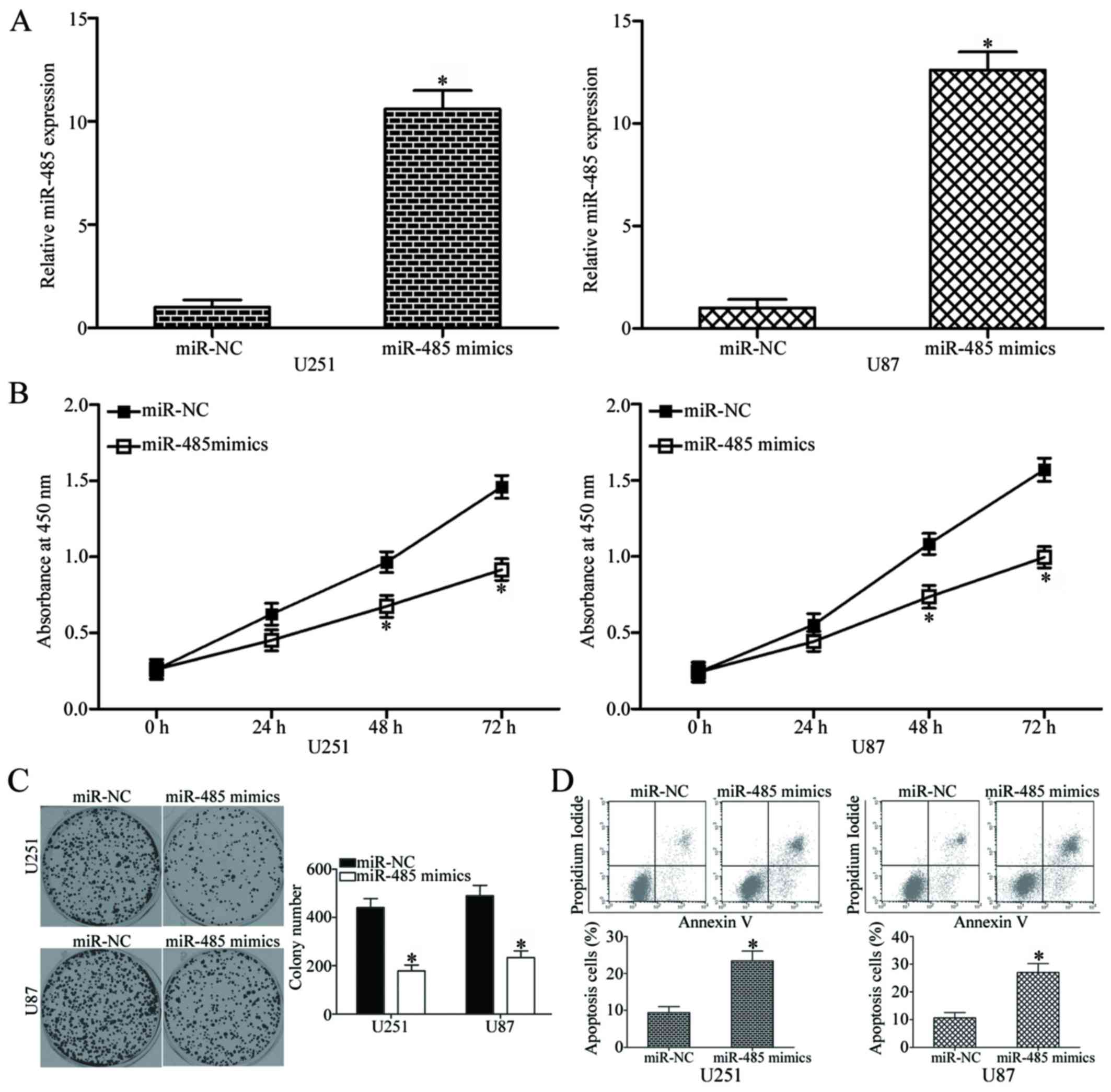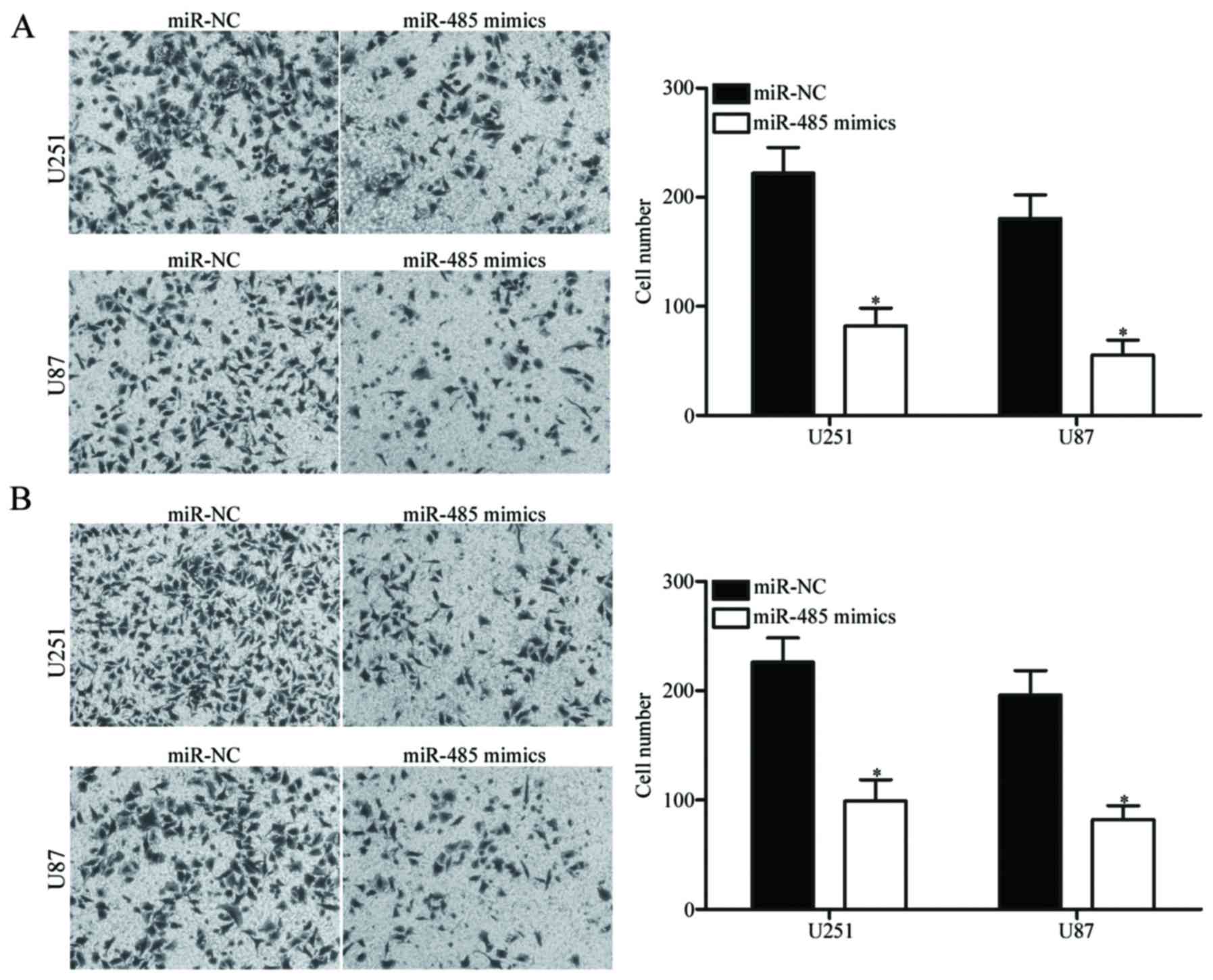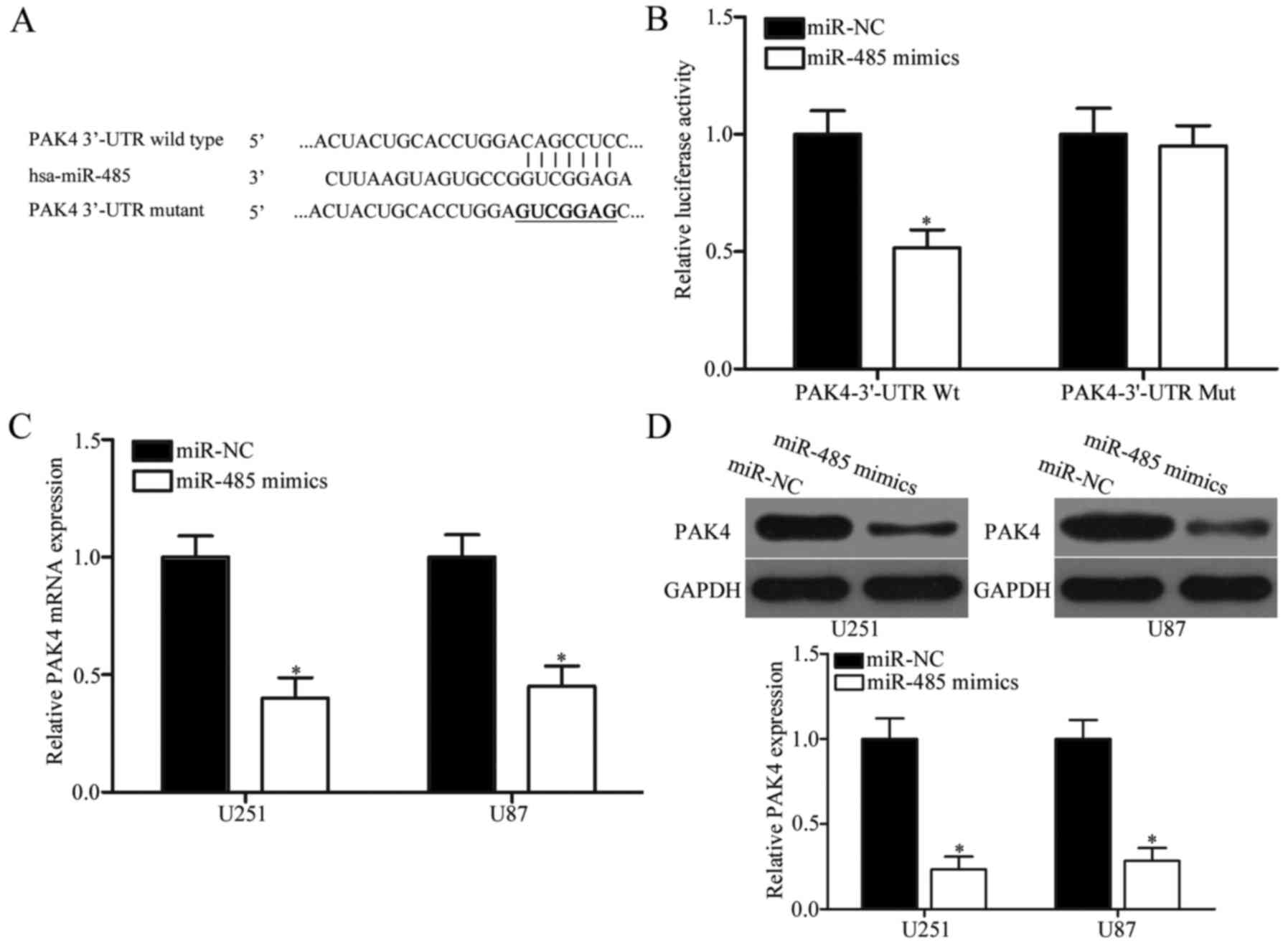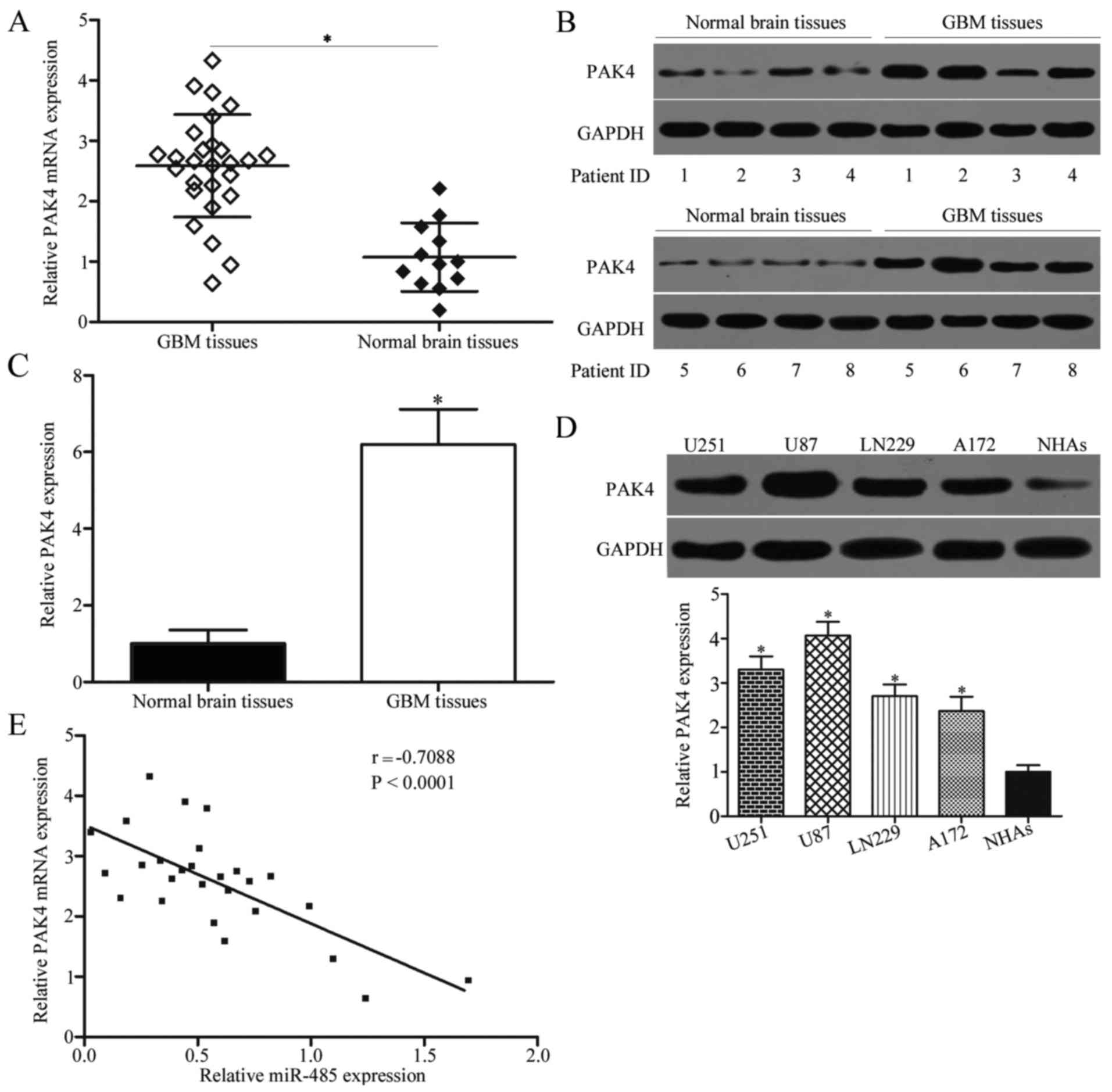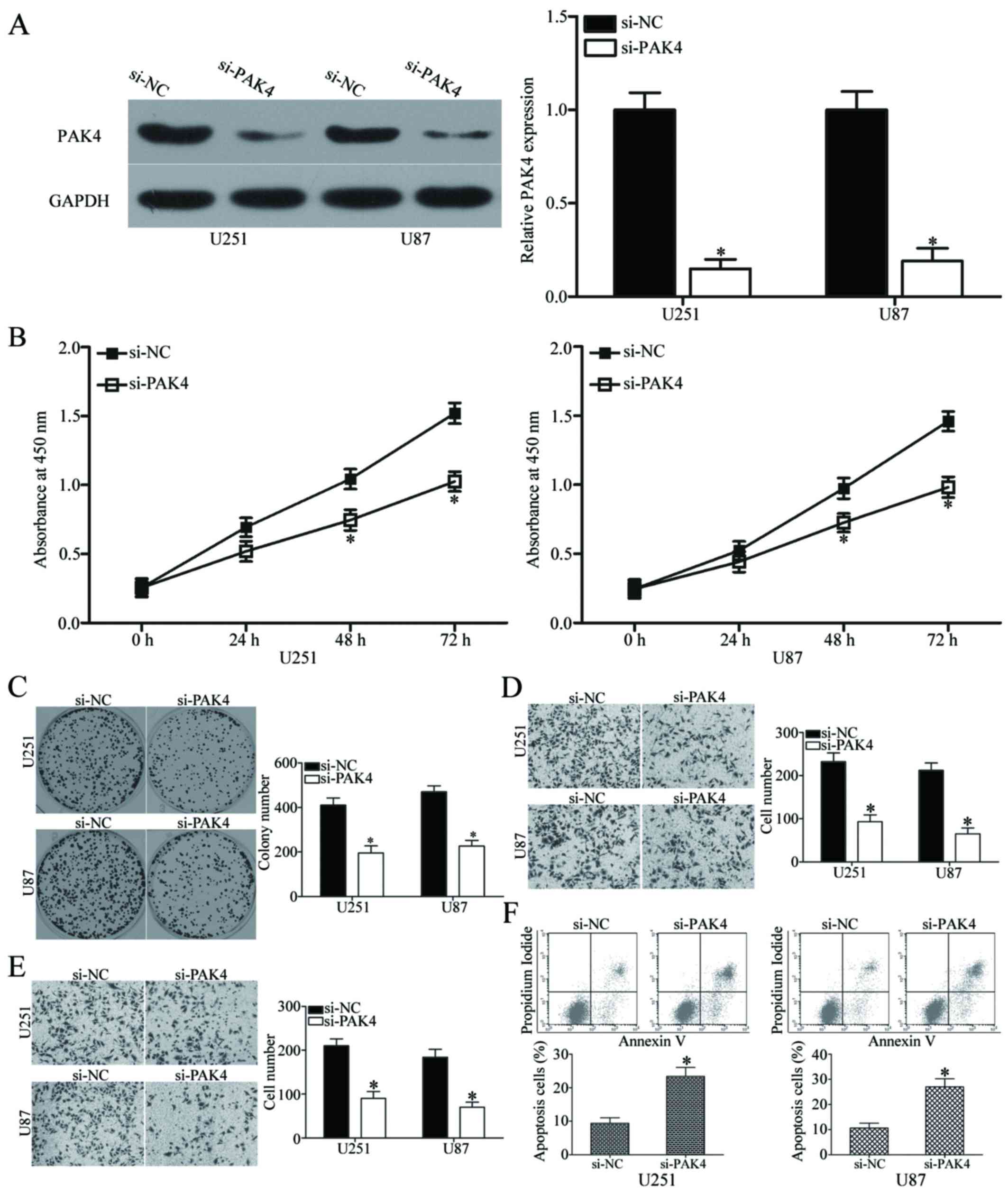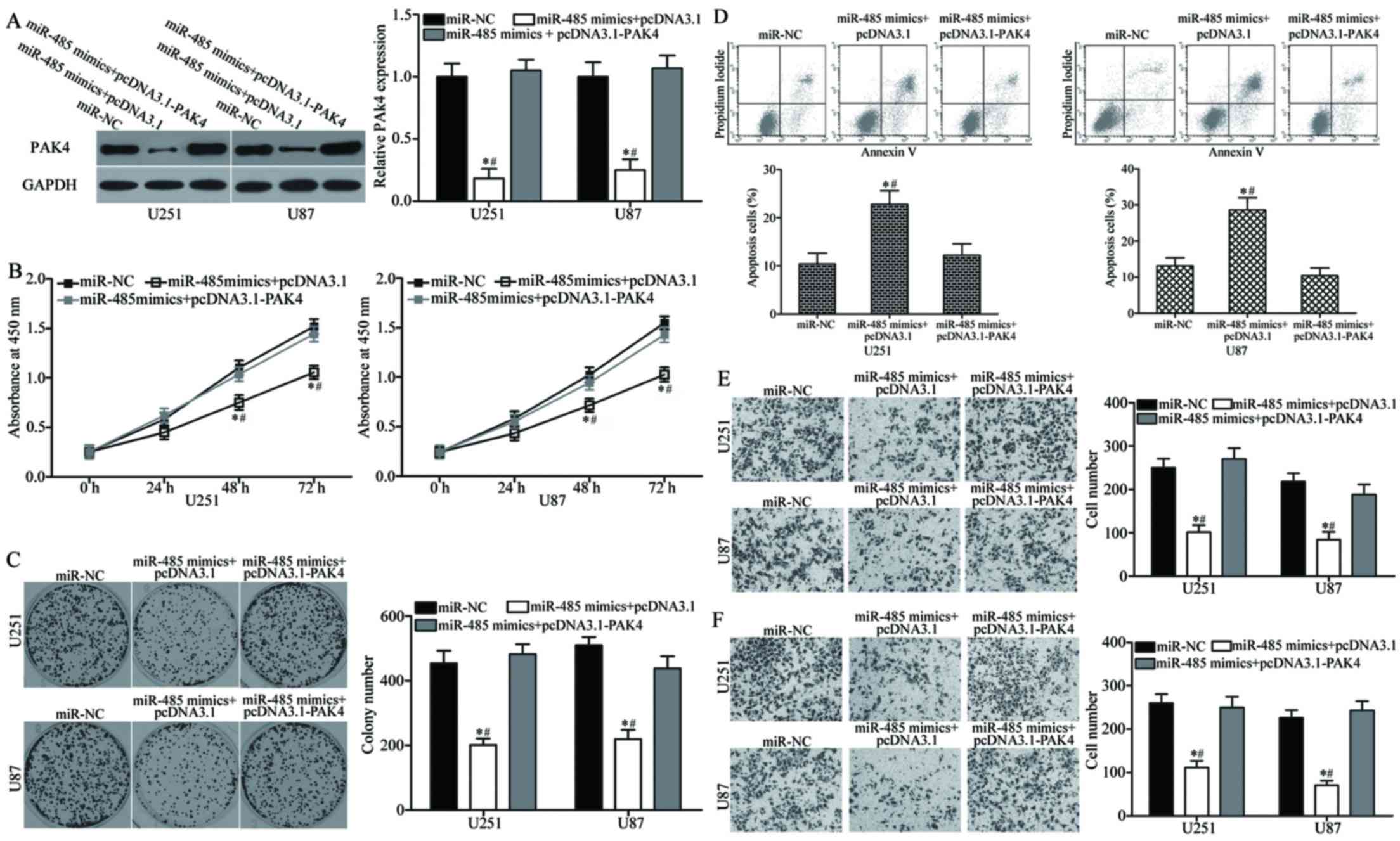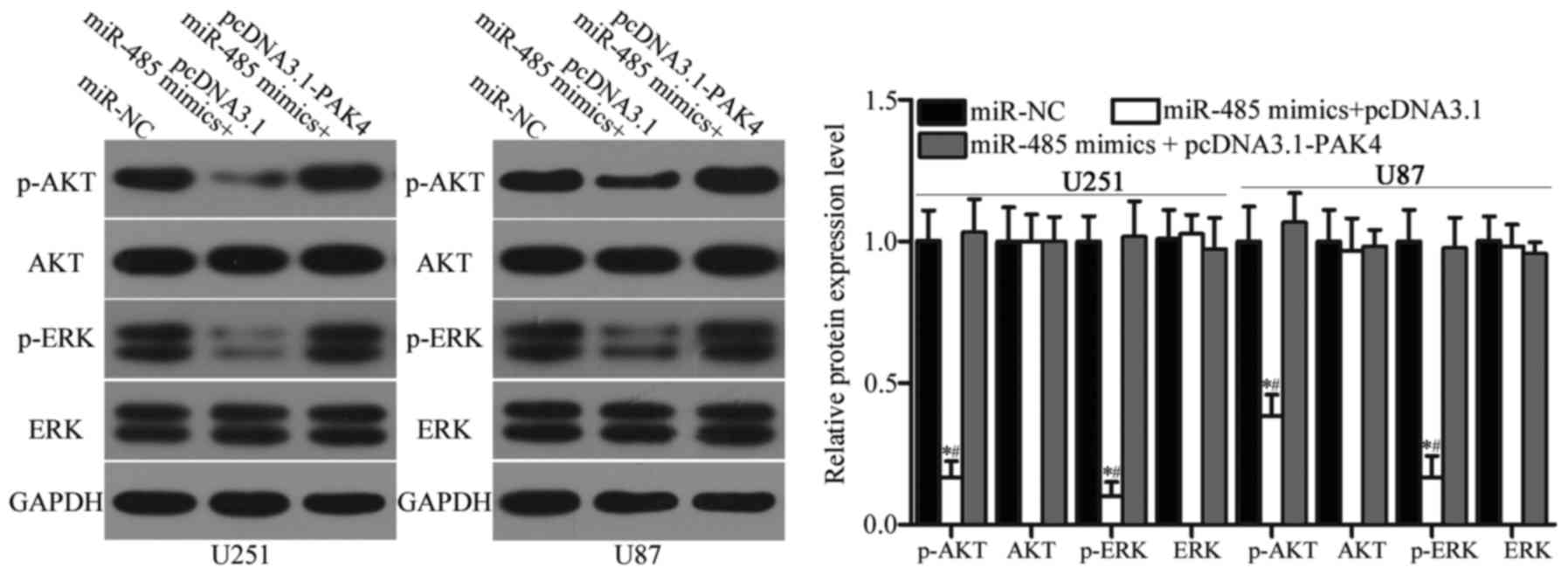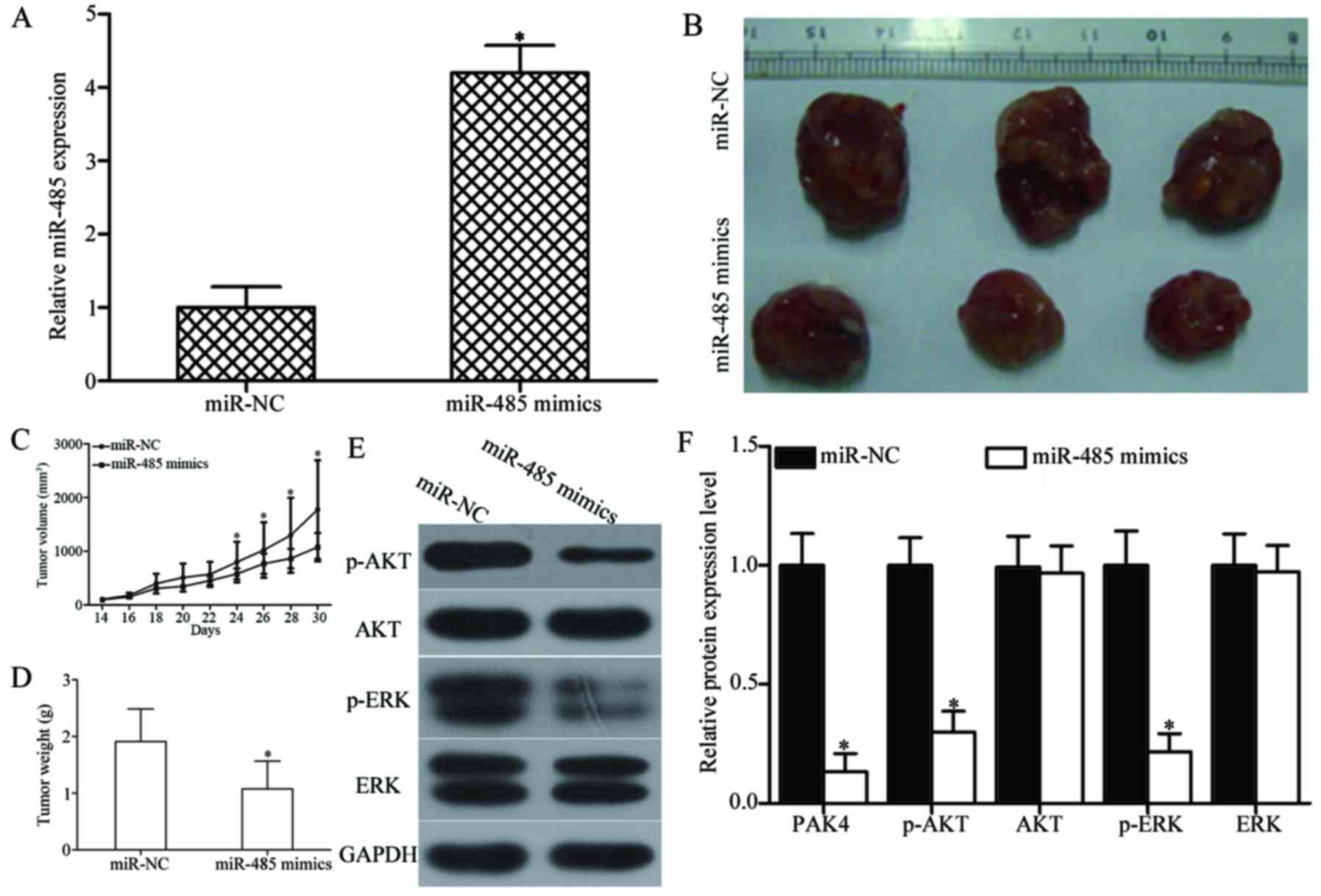MicroRNA-485 inhibits malignant biological behaviour of glioblastoma cells by directly targeting PAK4
- Authors:
- Published online on: September 14, 2017 https://doi.org/10.3892/ijo.2017.4122
- Pages: 1521-1532
Abstract
Introduction
Glioma, the most common and malignant brain tumour in human, originates from neural stromal cells and accounts for 80% of all malignant brain tumours in adults (1,2). Glioma can be divided into two groups according to the 2007 World Health Organisation classification: low grade (grades I and II) and high grade (grades III and IV) (2). Glioblastoma (GBM), regarded as grade IV glioma, is the most common histological subtype of glioma in adults (3). Rapid growth, cellular heterogeneity, angiogenesis, extensive invasion, hypoxia and necrosis are the histopathological hallmarks of GBM (4,5). Currently, surgical resection is the primary treatment method for GBM, whereas radiotherapy and chemotherapy are common adjuvant therapeutic approaches (6,7). Despite recent advances in multimodal therapies, the prognosis of GBM patients remains extremely poor, with an average 5-year survival rate of only 4–5% (8,9). Therefore, the elucidation of the molecular mechanisms of GBM and identification of novel and effective therapeutic strategies for patients with this disease are urgently needed.
MicroRNAs (miRNAs) are a family of small double- stranded, non-protein coding and short RNA molecules with lengths of ~21–25 nucleotides (10). miRNAs regulate gene expression levels by imperfectly pairing with complementary sites within the 3′-untranslated regions (3′-UTRs) of their target messenger RNAs (mRNAs), resulting in either degradation or translational repression of the target mRNAs (11,12). A miRNA may regulate numerous target genes, and one gene may be regulated by multiple miRNAs. Therefore, >60% of all human genes have been predicted to be regulated by miRNAs (13). Increasing studies have shown that miRNAs are involved in regulating various biological processes, including development, cell proliferation, differentiation, apoptosis, metabolism and signal transduction (14–16). Multiple bodies of evidence have indicated that miRNAs are abnormally expressed in almost all types of human cancer (17–19). Current studies have acknowledged that more than half of miRNAs are located in cancer-related genomic regions; this finding suggests that dysregulation of miRNAs plays important roles in carcinogenesis and cancer progression (20). Aberrantly overexpressed miRNAs can act as oncogenes through down-regulation of tumour suppressor genes, whereas downregulated miRNAs can function as tumour suppressors through negative regulation of oncogenes (21). Hence, miRNAs may serve as novel therapeutic targets for anticancer treatments.
Recent accumulating evidence has demonstrated that miR-485 (also known as miR-485-5p; www.mirbase.org/cgi-bin/mirna_entry.pl?acc=MI0002469) is involved in the development and progression of several types of human cancers (22–24). However, the expression level, exact role and underlying mechanisms of miR-485 in GBM remain unclear. The present study detected miR-485 in GBM, investigated the exact roles of miR-485 in GBM progression and elucidated the underlying molecular mechanism.
Material and methods
Clinical specimens
A total of 27 human GBM tissues were obtained from patients who were treated with surgical resection in Department of Neurosurgery, West China Hospital of Sichuan University between August, 2014 and February, 2016. Twelve normal brain tissues were obtained from patients with traumatic brain injury and who received partial resections of normal brain tissue to reduce increased intracranial pressure. Lineal relative of brain trauma patients agreed the use of patients normal brain tissues in this study. All tissue samples were immediately snap-frozen in liquid nitrogen and stored at −80°C until further use. This study was approved by the Ethics Committee of West China Hospital of Sichuan University. Written informed consent was obtained from all patients.
Cell lines
GBM cell lines (U251, U87, LN229 and A172) and HEK293T cell line were purchased from American Type Culture Collection (Manassas, VA, USA). The cells were kept in Dulbecco's modified Eagle's medium (DMEM; Invitrogen, Carlsbad, CA, USA) supplemented with 10% fetal bovine serum (FBS; Invitrogen, Carlsbad, CA, USA), 100 U/ml penicillin and 100 mg/ml streptomycin (Invitrogen). Normal human astrocytes (NHAs) were acquired from ScienCell Research Laboratories (Carlsbad, CA, USA) and cultured in astrocyte medium (ScienCell Research Laboratories). All cells were grown at 37°C in a humidified chamber containing 5% CO2.
Oligonucleotides, plasmid and transfection
miR-485 mimics and miRNA mimics negative control (miR-NC) were obtained from Shanghai GenePharma (Shanghai, China). Small interfering RNA targeting p21-activated kinase 4 (si-PAK4) and its negative control (si-NC) were purchased from Ribobio (Guangzhou, China). PAK4-overexpressing plasmid (pcDNA3.1-PAK4) and blank plasmid (pcDNA3.1) were purchased from the Chinese Academy of Sciences (Changchun, China). All oligonucleotides and plasmids were transfected into cells using Lipofectamine 2000 (Invitrogen) in accordance with the manufacturer's instructions. Six hours after transfection, the culture medium was replaced with fresh DMEM containing 10% FBS.
RNA isolation and reverse transcription-quantitative polymerase chain reaction (RT-qPCR)
Total RNA was isolated from tissue specimens or cells using the TRIzol reagent (Invitrogen) in accordance with the manufacturer's protocol. The concentration and quality of total RNA were determined using a Nanodrop® ND-1000 spectrophotometer (NanoDrop Technologies; Thermo Fisher Scientific, Inc., Pittsburgh, PA, USA). To quantify miR-485 expression, complementary DNA (cDNA) was synthesised from total RNA using a TaqMan miRNA reverse transcription kit (Applied Biosystems, Carlsbad, CA, USA). Relative miR-485 expression was determined by TaqMan miRNA PCR kit (Applied Biosystems) using an Applied Biosystems 7900HT Fast Real-Time PCR system (Applied Biosystems; Thermo Fisher Scientific, Inc.). For PAK4 mRNA expression, total RNA was reverse transcribed into cDNA using a PrimeScript RT Reagent kit (Takara Bio, Inc., Otsu, Japan). A SYBR Premix Ex Taq™ kit (Takara Bio, Inc.) was used to detect PAK4 mRNA expression. U6 and glyceralde-hyde 3-phosphate dehydrogenase (GAPDH) served as endogenous control for miR-485 and PAK4, respectively. The primers were designed as follows: miR-485, 5′-CCAAGCTTCACCCATTCCTAACAGGAC-3′ (forward) and 5′-CGGGATCCGTAGGTCAGTTACATGCATC-3′ (reverse); U6, 5′-GCTTCGGCAGCACATATACTAAAAT-3′ (forward) and 5′-CGCTTCACGAATTTGCGTGTCAT-3′ (reverse); PAK4, 5′-AGGGAAGGCGGGAGATGAG-3′ (forward) and 5′-TCAGTTGCTTGTTCGTGC-3′ (reverse); and GAPDH, 5′-GAAGGTGAAGGTCGGAGTC-3′ (forward) and 5′-GAAGATGGTGATGG GAT TTC-3′ (reverse). The relative expression was analysed by the 2−ΔΔCq method (25).
Cell counting kit 8 (CCK8) assay
The proliferative ability of GBM cells was assessed using CCK8 assay. Transfected cells were collected at 24 h post-transfection and seeded into 96-well plates at a density of 3×103 cells/well. Cells were incubated at 37°C in a humidified 5% CO2 atmosphere for 0, 24, 48 and 72 h. At each time point, CCK8 assay was performed in accordance with the manufacturer's instructions. In brief, 10 µl of CCK8 solution (Dojindo, Tokyo, Japan) was added to each well, and then the cells were incubated at 37°C for another 2 h. The absorbance at a wavelength of 450 nm was detected with an ELISA reader (Bio-Rad Laboratories, Inc., Hercules, CA, USA). Each experiment contained five replicates and repeated at least three times.
Colony formation assay
Transfected cells were harvested and mechanically dissociated into a single cell suspension. Subsequently, the cells were seeded into 6-well plates with a density of 1,000 cells/well. The plates were incubated at 37°C in a humidified atmosphere of 5% CO2 for 2 weeks. On day 15, the plates were washed with phosphate-buffered saline (PBS), fixed with 10% formalin and then stained with Methyl Violet (Beyotime Institute of Biotechnology, Shanghai, China). The colonies containing at least 50 cells were counted under a microscope (Olympus IX53; Olympus, Tokyo, Japan). All experiments were performed at least three times.
Transwell migration and invasion assay
Transwell migration and invasion assays were performed using an 8 µm-pore polycarbonate membrane Boyden chamber insert in a Transwell apparatus (Costar, Cambridge, MA, USA). For invasion assay, the chamber inserts were pre-coated with 20 µl of Matrigel (1:3 dilution; BD Bioscience, San Jose, CA, USA). For both assays, transfected cells were harvested and mechanically dissociated into a single cell suspension. Subsequently, 5×104 cells in FBS-free medium were added into the upper chamber, and a 500 µl culture medium containing 20% FBS was placed as a chemo-attractant in the lower chamber. The chambers were then incubated for 48 h at 37°C in a 5% CO2 incubator. Cells on the upper surface were scraped and washed away, whereas cells on the lower surface were fixed with 100% methanol, stained with 0.5% crystal violet and then subjected to microscopic inspection (magnification, x200). The values for migration and invasion abilities were obtained by counting five fields per membrane.
Flow cytometry analysis
Transfected cells were harvested at 48 h post-transfection using trypsinisation, washed in ice-cold PBS and then fixed in 80% ice-cold ethanol in PBS. Cell apoptosis was determined with the Annexin V-FITC apoptosis detection kit (Invitrogen) in accordance with the manufacturer's instructions. In brief, the cells were re-suspended in 300 µl of 1X binding buffer and then stained with 5 µl of FITC-Annexin V and 5 µl of propidium iodide (PI) for 20 min in the dark at room temperature. Cell apoptosis was quantified using a flow cytometry kit (Beckman Coulter Corp., Brea, CA, USA).
Tumour growth assay in nude mice
Eight 4- to 6-week-old BALB/c nude mice were purchased from Changzhou Cavens Laboratory Animal Center (Changzhou, China). In brief, transfected U87 cells (26–28) were harvested and mechanically dissociated into a single cell suspension. A total of 1×107 U87 cells (29–31) in 100 µl culture medium were subcutaneously injected into each nude mouse. The right armpit was injected with U87 cells transfected with miR-485 mimics. As a control, the left armpit was injected with U87 cells transfected with miR-NC. Tumour volumes were measured every 2 days and calculated using the formula 1/2 × tumour length × tumour width. At day 30, the nude mice were sacrificed, and the tumour xenografts were dissected and weighed. Western blot analysis was also performed to detect protein expression levels in tumour xenografts.
Bioinformatic analysis and luciferase reporter assay
Bioinformatic analysis was performed to predict the putative targets of miR-485 using Pictar (http://www.pictar.mdc-berlin.de/), TargetScan (http://www.targetscan.org/) and miRanda (http://www.microrna.org/). 'Human' was selected as the species, and 'hsa-miR-485' was entered. Putative miRNA: mRNA interaction was based on the total context score. The more negative the total context score, the higher the probability of miRNA: mRNA binding.
Luciferase reporter plasmids, namely, psiCHECK2-PAK4-3′-UTR wild-type (Wt) and psiCHECK2-PAK4-3′-UTR mutant (Mut), were synthesised and confirmed by GenePharma (Shanghai, China). HEK293T cells were seeded into 24-well plates at a density of 50–60% confluence. One day later, the cells were co-transfected with wild or mutant-type plasmid together with miR-485 mimics or miR-NC by using Lipofectamine 2000. After 48 h incubation, the cells were assayed with the Dual-Luciferase reporter assay system (Promega, Madison, WI, USA) in accordance with the manufacturer's instructions. Renilla luciferase was used for normalisation. Each assay was performed in triplicate and repeated three times.
Western blot analysis
The total proteins of tissues or cells were extracted using RIPA lysis buffer (Beyotime Institute of Biotechnology, Haimen, China) supplemented with 0.1 mg/ml phenylmethylsulphonyl fluoride, 1 mM sodium orthovanadate and 1 mg/ml aprotinin. A BCA assay kit (Pierce™; Thermo Fisher Scientific, Inc.) was used to determine protein concentration. Equal amounts of protein were separated by sodium dodecyl sulfate-polyacrylamide gel electrophoresis (SDS-PAGE) and then transferred onto polyvinylidene difluoride membranes (Millipore, Billerica, MA, USA). After blocking with 5% skimmed milk at room temperature for 2 h, the membranes were incubated overnight at 4°C with primary antibodies. All primary antibodies were purchased form Santa Cruz Biotechnology, Inc. (Santa Cruz, CA, USA), including mouse anti-human monoclonal PAK4 (sc-393367; 1:1,000 dilution), mouse anti-human monoclonal p-AKT (sc-271966; 1:1,000 dilution), mouse anti-human monoclonal AKT (sc-81434; 1:1,000 dilution), mouse anti-human monoclonal p-ERK (sc-81492; 1:1,000 dilution), mouse anti-human monoclonal ERK (sc-514302; 1:1,000 dilution) and mouse anti-human monoclonal GAPDH antibody (sc-32233; 1:1,000 dilution). Subsequently, the membranes were washed three times with Tris-buffered saline containing 0.1% Tween-20 and then probed with horseradish peroxidase-conjugated secondary immunoglobulin G goat anti-mouse (sc-2005; 1:5,000 dilution; Santa Cruz Biotechnology, Inc.) at room temperature for 2 h. Finally, the protein bands were visualised using enhanced chemiluminescence reagents (Bio-Rad Laboratories, Inc.) and band densities were analysed using AlphaEase FC software (version 4.0.1; ProteinSimple, San Jose, CA, USA).
Statistical analysis
Data are presented as mean ± SD. Data were analysed using SPSS 17.0 software (SPSS, Inc., Chicago, IL, USA). The difference between groups was compared with Student's t-test or one-way ANOVA plus multiple comparisons. The association between miR-485 and PAK4 mRNA expression was analysed through Spearman's correlation analysis. P<0.05 was used as the cut off for statistically significant differences.
Results
miR-485 is downregulated in GBM tissues and cell lines
To investigate the potential roles of miR-485 in GBM, RT-qPCR was first performed to detect miR-485 expression in 27 cases of GBM tissues and 12 cases of normal brain tissues. Results showed that the expression levels of miR-485 decreased in GBM tissues in comparison with that in normal brain tissues (P<0.05) (Fig. 1A). We further examined miR-485 expression in four GBM cell lines (U251, U87, LN229 and A172) and NHAs. As shown in Fig. 1B, miR-485 was downregulated in all tested GBM cells compared with NHAs (P<0.05). These results suggest that miR-485 is involved in GBM progression.
miR-485 overexpression inhibits cell proliferation and colony formation and increases apoptosis in GBM
To elucidate the role of miR-485 in GBM progression, miR-485 mimics or miR-NC was transfected into U251 and U87 cells, which have relatively low miR-485 expression among the four tested GBM cell lines. The relative expression of miR-485 after transfection was evaluated using RT-qPCR, and results showed that miR-485 was markedly upregulated in the U251 and U87 cells transfected with miR-485 mimics (P<0.05) (Fig. 2A). We next examined the effect of miR-485 overexpression on GBM cell proliferation by using CCK8 assay. As shown in Fig. 2B, upregulation of miR-485 inhibited U251 and U87 cell proliferation at both 48 and 72 h in comparison with that in the cells transfected with miR-NC (P<0.05). Furthermore, the results of the colony formation assay demonstrated that the U251 and U87 cells transfected with miR-485 mimics exhibited significantly fewer and smaller colonies in comparison with those transfected with miR-NC (P<0.05) (Fig. 2C). Flow cytometry analysis was further conducted to explore the effect of miR-485 on GBM cell apoptosis. In comparison with the miR-NC group, the rates of apoptosis in U251 and U87 cells were significantly increased by miR-485 mimics (P<0.05) (Fig. 2D). Taken together, these results suggest that miR-485 inhibits GBM cell proliferation and colony formation and induces apoptosis in vitro.
Upregulation of miR-485 decreases GBM cell migration and invasion
To determine whether the restoration of miR-485 expression affects the migration and invasion of GBM cells, Transwell migration and invasion assays were carried out in the U251 and U87 cells transfected with miR-485 mimics or miR-NC. As shown in Fig. 3A, the migratory ability of the U251 and U87 cells transfected with miR-485 mimics was significantly lower than that of the cells transfected with miR-NC (P<0.05). Similarly, the ectopic expression of miR-485 attenuated the invasion capacities of U251 and U87 cells (P<0.05) (Fig. 3B). These findings suggest that miR-485 can inhibit GBM cell metastasis in vitro.
PAK4 is a direct target of miR-485 in GBM
The potential targets of miR-485 were predicted through bioinformatic analysis to elucidate the molecular mechanism underlying the tumour-suppressing roles of miR-485 in GBM. Among hundreds of candidates, PAK4 was selected as a potential target of miR-485 (Fig. 4A) because PAK4 is upregulated in GBM and contributes to GBM progression (32,33). To examine the hypothesis that miR-485 targets the 3′-UTR of PAK4, luciferase reporter assay was performed. The wild- or mutant-type plasmid was transfected into HEK293T cells, together with miR-485 mimics or miR-NC. Fig. 4B shows that miR-485 upregulation reduced the luciferase activities of the Wt 3′-UTR of PAK4 (P<0.05). However, no significant difference was observed in the cells transfected with PAK4 3′-UTR Mut and miR-485 mimics; this result suggests that miR-485 can directly target the 3′-UTR of PAK4. RT-qPCR and western blot analyses were further conducted to explore whether miR-485 regulates endogenous PAK4 expression. Results indicated that enforced expression of miR-485 decreased PAK4 expression in U251 and U87 cells at the mRNA (P<0.05) (Fig. 4C) and protein (P<0.05) (Fig. 4D) levels. These results demonstrate that PAK4 is a direct target of miR-485 in GBM.
PAK4 is inversely associated with the expression of miR-485 in GBM tissues
To further characterise the association between PAK4 and miR-485, we detected PAK4 expression in 27 cases of GBM tissues and 12 cases of normal brain tissues. Results showed that PAK4 mRNA (P<0.05) (Fig. 5A) and protein (P<0.05) (Fig. 5B and C) levels were higher in GBM tissues than in normal brain tissues. We also measured PAK4 protein expression in GBM cell lines (U251, U87, LN229 and A172) and NHAs. As shown in Fig. 5D, PAK4 was highly expressed in the GBM cell lines compared with NHAs (P<0.05). Moreover, Spearman's correlation analysis revealed a significant and negative correlation between miR-485 and PAK4 mRNA expression in GBM tissues (r=−0.7088, P<0.0001) (Fig. 5E).
Downregulation of PAK4 exhibits a similar effect to miR-485 overexpression in GBM cells
Having verified that PAK4 is a direct target of miR-485 in GBM, we investigated whether PAK4 underexpression exerts a tumour-suppressing effect similar to miR-485 overexpression in GBM. We transfected si-PAK4 or si-NC into U251 and U87 cells to knock down the endogenous expression of PAK4. After transfection, western blot analysis confirmed that PAK4 was significantly downregulated in the si-PAK4-transfected U251 and U87 cells (P<0.05) (Fig. 6A). The effects of PAK4 knockdown on cell proliferation, colony formation, apoptosis, migration and invasion were evaluated in U251 and U87 cells using CCK8, colony formation, flow cytometry, Transwell migration and invasion assays, respectively. Results showed that PAK4 downregulation dramatically inhibited the proliferation at both 48 h and 72 h (P<0.05) (Fig. 6B), colony formation (P<0.05) (Fig. 6C), migration (P<0.05) (Fig. 6D), invasion (P<0.05) (Fig. 6E) and promoted apoptosis (P<0.05) (Fig. 6F) of U251 and U87 cells. These results are consistent with the effect of miR-485 overexpression on GBM cells and further suggest that PAK4 is a functional downstream target of miR-485.
PAK4 overexpression reverses miR-485 tumour-suppressing functions in GBM
We performed a series of rescue experiments to determine whether PAK4 overexpression can rescue the tumour-suppressing roles of miR-485 in GBM. U251 and U87 cells were transfected with miR-485 mimics together with or without pcDNA3.1-PAK4. Western blot analysis indicated that the decreased level of PAK4 induced by miR-485 overexpression was rescued by cotransfection of pcDNA3.1-PAK4 (P<0.05) (Fig. 7A). Functional experiments revealed that the reintroduction of PAK4 can attenuate the effects of miR-485 on the proliferation (P<0.05) (Fig. 7B), colony formation (P<0.05) (Fig. 7C), apoptosis (P<0.05) (Fig. 7D), migration (P<0.05) (Fig. 7E) and invasion (P<0.05) (Fig. 7F) of U251 and U87 cells. Collectively, these findings suggest that PAK4 acts as a downstream effector of miR-485 in the regulation of malignant phenotypes of GBM in vitro.
miR-485 inhibits the activation of the AKT and ERK signalling pathways in GBM
Previous studies reported that PAK4 is involved in the regulation of the AKT and ERK signalling pathways (34–36). Considering the regulatory effect of miR-485 on PAK4 in GBM, we hypothesised that the restoration of miR-485 expression may inactivate the AKT and ERK signalling pathways. Hence, we detected the expression levels of AKT, p-AKT, ERK and p-ERK in U251 and U87 cells transfected with miR-NC, miR-485 mimics or miR-485 mimics cotransfected with pcDNA3.1-PAK4. As shown in Fig. 8, miR-485 overexpression reduced p-AKT and p-ERK expression in U251 and U87 cells (P<0.05). However, upregulation of miR-485 did not affect AKT and ERK expression entirely. In addition, the expression levels of p-AKT and p-ERK were recovered in the miR-485 mimic-transfected U251 and U87 cells cotransfected with pcDNA3.1-PAK4. These results suggest that miR-485 inactivates the AKT and ERK signalling pathways by regulating PAK4 in GBM.
miR-485 suppresses GBM cell growth in vivo
We further explored the effect of miR-485 overexpression on GBM cell growth in vivo. U87 cells transfected with miR-485 mimics or miR-NC were implanted into the left and right flanks of nude mice by subcutaneous injection, respectively. At 30 days, the nude mice were sacrificed. Firstly, RT-qPCR analysis was performed to detect miR-485 expression in tumour xenografts. As shown in Fig. 9A, miR-485 expression was significantly upregulated in miR-485 mimics-transfected tumour xenografts (P<0.05). The tumour volume of the miR-485 mimic groups significantly decreased compared with that of the miR-NC groups at 30 days (P<0.05) (Fig. 9B and C). Furthermore, the average tumour weight of the miR-485 mimic groups was significantly lower than that of the miR-NC group (P<0.05) (Fig. 9D). Western blot analysis also showed that the expression levels of PAK4, and key components, including p-AKT and p-ERK, of the AKT and ERK signalling pathways were significantly reduced in the xenograft tumour tissues with miR-485 overexpression (P<0.05) (Fig. 9E and F). These results suggest that miR-485 inhibits GBM tumour growth in vivo by directly targeting PAK4 and indirectly regulating the AKT and ERK signalling pathways.
Discussion
miRNA dysregulation is a common feature of human cancers, including GBM (37,38). Previous studies have demonstrated that miRNAs are a novel class of regulatory molecules in various human cancers (39,40). The abnormal expression of miRNAs is closely related to malignant biological behaviour, which include proliferation, invasion, apoptosis, cell cycle and angiogenesis (41–43). Therefore, miRNAs may be investigated as a novel candidate and screening tool in the clinical diagnosis, therapy and prognosis of GBM. The present study initially found that miR-485 was significantly downregulated in GBM tissues and cell lines. Upregulation of miR-485 inhibited GBM cell proliferation, migration and invasion; increased apoptosis in vitro; and reduced tumour growth in vivo. In addition, PAK4 was validated as a direct target of miR-485 in GBM. PAK4 was highly expressed in GBM tissues and negatively correlated with miR-485 expression. Furthermore, PAK4 downregulation may mimic the functions of miR-485 in GBM cells. PAK4 overexpression can rescue the tumour-suppressing roles of miR-485 in GBM. Moreover, miR-485 inhibited the activation of the AKT and ERK signalling pathways in GBM. These findings suggest that miR-485 can be potentially developed as an effective therapeutic target for the treatment of patients with GBM.
The abnormal expression of miR-485 has been reported in numerous types of cancers. For example, the expression level of miR-485 is decreased in gastric cancer tissues and cell lines. Low miR-485 expression is correlated with tumour size, invasion depth, lymph node metastasis and advanced tumour-node-metastasis (TNM) stage. Gastric cancer patients with low miR-485 expression have a shorter survival time than those with high miR-485 expression (44). In breast cancer, miR-485 is downregulated in tumour tissues and negatively correlates with the development and metastasis potential of breast cancer (45). miR-485 is expressed at low level in hepatocellular carcinoma tissues and cell lines. Reduced expression of miR-485 is significantly correlated with tumour size, tumour number, TNM stage and metastasis in patients with hepatocellular carcinoma (46,47). The expression level of miR-485 is reduced in four lung adenocarcinoma cell lines and tissues. Decreased miR-485 expression is associated with tumour metastasis in patients with lung adenocarcinoma (22). Downregulation of miR-485 was also observed in bladder cancer (23) and melanoma (24). These findings suggest that miR-485 is a therapeutic marker for diagnosis and prognosis.
Previous studies demonstrated that miR-485 plays important roles in tumourigenesis and tumour development. For instance, Liu et al (43) reported that miR-485 inhibits migration, invasion and epithelial-to-mesenchymal transition and increases cisplatin-induced cell death in oral tongue squamous cell carcinoma. Kang et al (48) found that miR-485 upregulation suppresses gastric cancer cell metastasis, sphere formation in vitro and reduces cell growth in vitro and in vivo. Lou et al (45,49) demonstrated that ectopic expression of miR-485 attenuates the mitochondrial respiration, proliferation and motility of breast cancer cells. Sun et al (46,47) revealed that enforced expression of miR-485 represses the proliferation and metastasis of hepatocellular carcinoma cells in vitro and decreases tumour growth in vivo. Mou and Lou (22) indicated that the restoration of miR-485 expression inhibits cell metastasis and epithelial-to-mesenchymal transition of lung adenocarcinoma. These findings suggest that miR-485 can be investigated as a potential target for the therapeutic treatment of specific types of cancer.
Several targets of miR-485 have been validated, such as PAK1 (43) in oral tongue squamous cell carcinoma, Flot1 (48) in gastric cancer, PGC-1α (45) in breast cancer, stanniocalcin 2 (47) and EMMPRIN (46) in hepatocellular carcinoma, Flot2 (22) in lung adenocarcinoma, HMGA2 (23) in bladder cancer and Frizzled7 (24) in melanoma. In the current study, PAK4 was identified as a direct and functional downstream target of miR-485 in GBM. PAKs, a family of serine/threonine protein kinases, are best characterised as downstream effectors of Rac and Cdc42 (50). PAK4 is a member of the PAK family and is overexpressed and/or hyperactivated in multiple types of human cancer, including cervical cancer (51), ovarian cancer (52), anal cancer (53), colorectal cancer (54), breast cancer (55), renal cell carcinoma (56) and head and neck squamous cell carcinoma (57). PAK4 is reportedly correlated with tumourigenesis and tumour development by regulating cell proliferation, apoptosis, migration, invasion, actin cytoskeletal changes and cytoskeletal organisation (58–60).
In glioma, PAK4 is upregulated and significantly correlated with pathological grades. PAK4 downregulation represses glioma cell proliferation, motility and adhesion (32). In addition, PAK4 plays important roles in GBM cell senescence (33). Considering the importance and role of PAK4 in GBM, regulating the miR-485/PAK4 axis may offer novel therapeutic opportunities to target this aggressive cancer.
In conclusion, miR-485 is significantly downregulated in GBM tissues and cell lines. Upregulation of miR-485 suppresses GBM cell proliferation, colony formation, migration and invasion; increases apoptosis in vitro; and reduces tumour growth in vivo. Furthermore, PAK4 is a direct and functional target of miR-485 in GBM. Moreover, miR-485 overexpression inhibits the activation of the AKT and ERK signalling pathways in GBM. Further research exploring the anticancer role of miR-485 in GBM may contribute to the development of new therapeutic strategies for patients with this disease.
References
|
Jungk C, Chatziaslanidou D, Ahmadi R, Capper D, Bermejo JL, Exner J, von Deimling A, Herold-Mende C and Unterberg A: Chemotherapy with BCNU in recurrent glioma: Analysis of clinical outcome and side effects in chemotherapy-naïve patients. BMC Cancer. 16:812016. View Article : Google Scholar | |
|
Wu CX, Lin GS, Lin ZX, Zhang JD, Chen L, Liu SY, Tang WL, Qiu XX and Zhou CF: Peritumoral edema on magnetic resonance imaging predicts a poor clinical outcome in malignant glioma. Oncol Lett. 10:2769–2776. 2015. | |
|
Kovic B and Xie F: Economic evaluation of bevacizumab for the first-line treatment of newly diagnosed glioblastoma multiforme. J Clin Oncol. 33:2296–2302. 2015. View Article : Google Scholar : PubMed/NCBI | |
|
Zhang R, Luo H, Wang S, Chen W, Chen Z, Wang HW, Chen Y, Yang J, Zhang X, Wu W, et al: MicroRNA-377 inhibited proliferation and invasion of human glioblastoma cells by directly targeting specificity protein 1. Neuro Oncol. 16:1510–1522. 2014. View Article : Google Scholar : PubMed/NCBI | |
|
Lukiw WJ, Cui JG, Li YY and Culicchia F: Up-regulation of micro-RNA-221 (miRNA-221; chr Xp11.3) and caspase-3 accompanies down-regulation of the survivin-1 homolog BIRC1 (NAIP) in glioblastoma multiforme (GBM). J Neurooncol. 91:27–32. 2009. View Article : Google Scholar | |
|
Nikaki A, Piperi C and Papavassiliou AG: Role of microRNAs in gliomagenesis: Targeting miRNAs in glioblastoma multiforme therapy. Expert Opin Investig Drugs. 21:1475–1488. 2012. View Article : Google Scholar : PubMed/NCBI | |
|
Chaudhry MA, Sachdeva H and Omaruddin RA: Radiation-induced micro-RNA modulation in glioblastoma cells differing in DNA-repair pathways. DNA Cell Biol. 29:553–561. 2010. View Article : Google Scholar : PubMed/NCBI | |
|
Stupp R, Mason WP, van den Bent MJ, Weller M, Fisher B, Taphoorn MJ, Belanger K, Brandes AA, Marosi C, Bogdahn U, et al European Organisation for Research and Treatment of Cancer Brain Tumor and Radiotherapy Groups; National Cancer Institute of Canada Clinical Trials Group: Radiotherapy plus concomitant and adjuvant temozolomide for glioblastoma. N Engl J Med. 352:987–996. 2005. View Article : Google Scholar : PubMed/NCBI | |
|
Van Meir EG, Hadjipanayis CG, Norden AD, Shu HK, Wen PY and Olson JJ: Exciting new advances in neuro-oncology: The avenue to a cure for malignant glioma. CA Cancer J Clin. 60:166–193. 2010. View Article : Google Scholar : PubMed/NCBI | |
|
Bartel DP: MicroRNAs: Genomics, biogenesis, mechanism, and function. Cell. 116:281–297. 2004. View Article : Google Scholar : PubMed/NCBI | |
|
Bartel DP: MicroRNAs: Target recognition and regulatory functions. Cell. 136:215–233. 2009. View Article : Google Scholar : PubMed/NCBI | |
|
Nilsen TW: Mechanisms of microRNA-mediated gene regulation in animal cells. Trends Genet. 23:243–249. 2007. View Article : Google Scholar : PubMed/NCBI | |
|
Lewis BP, Shih IH, Jones-Rhoades MW, Bartel DP and Burge CB: Prediction of mammalian microRNA targets. Cell. 115:787–798. 2003. View Article : Google Scholar : PubMed/NCBI | |
|
Kushlinskii NE, Fridman MV and Braga EA: Molecular mechanisms and microRNAs in osteosarcoma pathogenesis. Biochemistry (Mosc). 81:315–328. 2016. View Article : Google Scholar | |
|
Dallaire A and Simard MJ: The implication of microRNAs and endo-siRNAs in animal germline and early development. Dev Biol. 416:18–25. 2016. View Article : Google Scholar : PubMed/NCBI | |
|
Lu YC, Chang JT, Chan EC, Chao YK, Yeh TS, Chen JS and Cheng AJ: miR-196, an Emerging Cancer Biomarker for Digestive Tract Cancers. J Cancer. 7:650–655. 2016. View Article : Google Scholar : PubMed/NCBI | |
|
Li Y, Wang Z, Li Y and Jing R: MicroRNA-29a functions as a potential tumor suppressor through directly targeting CDC42 in non-small cell lung cancer. Oncol Lett. 13:3896–3904. 2017.PubMed/NCBI | |
|
Zhao Y, Li Y, Lou G, Zhao L, Xu Z, Zhang Y and He F: miR-137 targets estrogen-related receptor alpha and impairs the proliferative and migratory capacity of breast cancer cells. PLoS One. 7:e391022012. View Article : Google Scholar : PubMed/NCBI | |
|
Garzon R, Calin GA and Croce CM: MicroRNAs in cancer. Annu Rev Med. 60:167–179. 2009. View Article : Google Scholar : PubMed/NCBI | |
|
Guo H, Ingolia NT, Weissman JS and Bartel DP: Mammalian microRNAs predominantly act to decrease target mRNA levels. Nature. 466:835–840. 2010. View Article : Google Scholar : PubMed/NCBI | |
|
Manikandan J, Aarthi JJ, Kumar SD and Pushparaj PN: Oncomirs: The potential role of non-coding microRNAs in understanding cancer. Bioinformation. 2:330–334. 2008. View Article : Google Scholar : PubMed/NCBI | |
|
Mou X and Liu S: miR-485 inhibits metastasis and EMT of lung adenocarcinoma by targeting Flot2. Biochem Biophys Res Commun. 477:521–526. 2016. View Article : Google Scholar : PubMed/NCBI | |
|
Chen Z, Li Q, Wang S and Zhang J: miR 485 5p inhibits bladder cancer metastasis by targeting HMGA2. Int J Mol Med. 36:1136–1142. 2015. View Article : Google Scholar : PubMed/NCBI | |
|
Wu J, Li J, Ren J and Zhang D: MicroRNA-485-5p represses melanoma cell invasion and proliferation by suppressing Frizzled7. Biomed Pharmacother. 90:303–310. 2017. View Article : Google Scholar : PubMed/NCBI | |
|
Livak KJ and Schmittgen TD: Analysis of relative gene expression data using real-time quantitative PCR and the 2(−Delta Delta C(T)) method. Methods. 25:402–408. 2001. View Article : Google Scholar | |
|
Wang XP, Zhou J, Han M, Chen CB, Zheng YT, He XS and Yuan XP: MicroRNA-34a regulates liver regeneration and the development of liver cancer in rats by targeting Notch signaling pathway. Oncotarget. 8:13264–13276. 2017.PubMed/NCBI | |
|
Wang J, Liu H, Tian L, Wang F, Han L, Zhang W and Bai YA: miR-15b inhibits the progression of glioblastoma cells through targeting insulin-like growth factor receptor 1. Horm Cancer. 8:49–57. 2017. View Article : Google Scholar | |
|
Zhu Q, Gong L, Wang J, Tu Q, Yao L, Zhang JR, Han XJ, Zhu SJ, Wang SM, Li YH, et al: miR-10b exerts oncogenic activity in human hepatocellular carcinoma cells by targeting expression of CUB and sushi multiple domains 1 (CSMD1). BMC Cancer. 16:8062016. View Article : Google Scholar : PubMed/NCBI | |
|
Cai WX, Zheng LW, Ma L, Huang HZ, Yu RQ and Zwahlen RA: Tumorigenicity and validity of fluorescence labelled mesenchymal and epithelial human oral cancer cell lines in nude mice. BioMed Res Int. 2016:48979862016. View Article : Google Scholar : PubMed/NCBI | |
|
Ma L, Zhang X, Wang Z, Chen Y, Wei J and Hu L: Establishment of a novel myelodysplastic syndrome (MDS) xenotransplantation model. Clin Lab. 62:1651–1659. 2016. View Article : Google Scholar | |
|
Wu Z, Cai X, Huang C, Xu J and Liu A: miR-497 suppresses angiogenesis in breast carcinoma by targeting HIF-1α. Oncol Rep. 35:1696–1702. 2016. View Article : Google Scholar : PubMed/NCBI | |
|
Kesanakurti D, Chetty C, Rajasekhar Maddirela D, Gujrati M and Rao JS: Functional cooperativity by direct interaction between PAK4 and MMP-2 in the regulation of anoikis resistance, migration and invasion in glioma. Cell Death Dis. 3:e4452012. View Article : Google Scholar : PubMed/NCBI | |
|
Franovic A, Elliott KC, Seguin L, Camargo MF, Weis SM and Cheresh DA: Glioblastomas require integrin αvβ3/PAK4 signaling to escape senescence. Cancer Res. 75:4466–4473. 2015. View Article : Google Scholar : PubMed/NCBI | |
|
Li SQ, Wang ZH, Mi XG, Liu L and Tan Y: miR-199a/b-3p suppresses migration and invasion of breast cancer cells by downregulating PAK4/MEK/ERK signaling pathway. IUBMB Life. 67:768–777. 2015. View Article : Google Scholar : PubMed/NCBI | |
|
Xue J, Chen LZ, Li ZZ, Hu YY, Yan SP and Liu LY: MicroRNA-433 inhibits cell proliferation in hepatocellular carcinoma by targeting p21 activated kinase (PAK4). Mol Cell Biochem. 399:77–86. 2015. View Article : Google Scholar | |
|
Fu X, Feng J, Zeng D, Ding Y, Yu C and Yang B: PAK4 confers cisplatin resistance in gastric cancer cells via PI3K/Akt- and MEK/ERK-dependent pathways. Biosci Rep. 34:342014. View Article : Google Scholar | |
|
Huang Q, Zhang XW, Ma YS, Lu GX, Xie RT, Yang HQ, Lv ZW, Zhong XM, Liu T, Huang SX, et al: Up-regulated microRNA-299 corrected with poor prognosis of glioblastoma multiforme patients by targeting ELL2. Jpn J Clin Oncol. 47:590–596. 2017. View Article : Google Scholar : PubMed/NCBI | |
|
Yuan Y, Zhang H, Liu X, Lu Z, Li G, Lu M and Tao X: MicroRNA signatures predict prognosis of patients with glioblastoma multiforme through the cancer genome atlas. Oncotarget. 8:58386–58393. 2017.PubMed/NCBI | |
|
Iorio MV and Croce CM: microRNA involvement in human cancer. Carcinogenesis. 33:1126–1133. 2012. View Article : Google Scholar : PubMed/NCBI | |
|
Garzon R, Marcucci G and Croce CM: Targeting microRNAs in cancer: Rationale, strategies and challenges. Nat Rev Drug Discov. 9:775–789. 2010. View Article : Google Scholar : PubMed/NCBI | |
|
Zhi T, Jiang K, Zhang C, Xu X, Wu W, Nie E, Yu T, Zhou X, Bao Z, Jin X, et al: MicroRNA-1301 inhibits proliferation of human glioma cells by directly targeting N-Ras. Am J Cancer Res. 7:982–998. 2017.PubMed/NCBI | |
|
Zhang P, Kong F, Deng X, Yu Y, Hou C, Liang T and Zhu L: MicroRNA-326 suppresses the proliferation, migration and invasion of cervical cancer cells by targeting ELK1. Oncol Lett. 13:2949–2956. 2017.PubMed/NCBI | |
|
Liu N, Zhang L, Wang Z, Cheng Y, Zhang P, Wang X, Wen W, Yang H, Liu H, Jin W, et al: MicroRNA-101 inhibits proliferation, migration and invasion of human glioblastoma by targeting SOX9. Oncotarget. 8:19244–19254. 2017. | |
|
Jing LL and Mo XM: Reduced miR-485-5p expression predicts poor prognosis in patients with gastric cancer. Eur Rev Med Pharmacol Sci. 20:1516–1520. 2016.PubMed/NCBI | |
|
Lou C, Xiao M, Cheng S, Lu X, Jia S, Ren Y and Li Z: miR-485-3p and miR-485-5p suppress breast cancer cell metastasis by inhibiting PGC-1α expression. Cell Death Dis. 7:e21592016. View Article : Google Scholar | |
|
Sun X, Liu Y, Li M, Wang M and Wang Y: Involvement of miR-485-5p in hepatocellular carcinoma progression targeting EMMPRIN. Biomed Pharmacother. 72:58–65. 2015. View Article : Google Scholar : PubMed/NCBI | |
|
Guo GX, Li QY, Ma WL, Shi ZH and Ren XQ: MicroRNA-485-5p suppresses cell proliferation and invasion in hepatocellular carcinoma by targeting stanniocalcin 2. Int J Clin Exp Pathol. 8:12292–12299. 2015. | |
|
Kang M, Ren MP, Zhao L, Li CP and Deng MM: miR-485-5p acts as a negative regulator in gastric cancer progression by targeting flotillin-1. Am J Transl Res. 7:2212–2222. 2015. | |
|
Anaya-Ruiz M, Bandala C and Perez-Santos JL: miR-485 acts as a tumor suppressor by inhibiting cell growth and migration in breast carcinoma T47D cells. Asian Pac J Cancer Prev. 14:3757–3760. 2013. View Article : Google Scholar : PubMed/NCBI | |
|
Bokoch GM: Biology of the p21-activated kinases. Annu Rev Biochem. 72:743–781. 2003. View Article : Google Scholar : PubMed/NCBI | |
|
Shu XR, Wu J, Sun H, Chi LQ and Wang JH: PAK4 confers the malignance of cervical cancers and contributes to the cisplatin-resistance in cervical cancer cells via PI3K/AKT pathway. Diagn Pathol. 10:1772015. View Article : Google Scholar : PubMed/NCBI | |
|
Helleman J, Jansen MP, Span PN, van Staveren IL, Massuger LF, Meijer-van Gelder ME, Sweep FC, Ewing PC, van der Burg ME, Stoter G, et al: Molecular profiling of platinum resistant ovarian cancer. Int J Cancer. 118:1963–1971. 2006. View Article : Google Scholar | |
|
Waalkes S, Atschekzei F, Kramer MW, Hennenlotter J, Vetter G, Becker JU, Stenzl A, Merseburger AS, Schrader AJ, Kuczyk MA, et al: Fibronectin 1 mRNA expression correlates with advanced disease in renal cancer. BMC Cancer. 10:5032010. View Article : Google Scholar : PubMed/NCBI | |
|
Song B, Wang W, Zheng Y, Yang J and Xu Z: p21-activated kinase 1 and 4 were associated with colorectal cancer metastasis and infiltration. J Surg Res. 196:130–135. 2015. View Article : Google Scholar : PubMed/NCBI | |
|
Ruiz-Garcia E, Scott V, Machavoine C, Bidart JM, Lacroix L, Delaloge S and Andre F: Gene expression profiling identifies fibronectin 1 and CXCL9 as candidate biomarkers for breast cancer screening. Br J Cancer. 102:462–468. 2010. View Article : Google Scholar : PubMed/NCBI | |
|
Liu W, Yang Y, Liu Y, Liu H, Zhang W, Xu L, Zhu Y and Xu J: p21-activated kinase 4 predicts early recurrence and poor survival in patients with nonmetastatic clear cell renal cell carcinoma. Urol Oncol. 33:205.e213–221. 2015. | |
|
Jerhammar F, Ceder R, Garvin S, Grénman R, Grafström RC and Roberg K: Fibronectin 1 is a potential biomarker for radioresistance in head and neck squamous cell carcinoma. Cancer Biol Ther. 10:1244–1251. 2010. View Article : Google Scholar : PubMed/NCBI | |
|
Gnad F, Young A, Zhou W, Lyle K, Ong CC, Stokes MP, Silva JC, Belvin M, Friedman LS, Koeppen H, et al: Systems-wide analysis of K-Ras, Cdc42, and PAK4 signaling by quantitative phosphoproteomics. Mol Cell Proteomics. 12:2070–2080. 2013. View Article : Google Scholar : PubMed/NCBI | |
|
Siu MK, Chan HY, Kong DS, Wong ES, Wong OG, Ngan HY, Tam KF, Zhang H, Li Z, Chan QK, et al: p21-activated kinase 4 regulates ovarian cancer cell proliferation, migration, and invasion and contributes to poor prognosis in patients. Proc Natl Acad Sci USA. 107:18622–18627. 2010. View Article : Google Scholar : PubMed/NCBI | |
|
Ahmed T, Shea K, Masters JR, Jones GE and Wells CM: A PAK4-LIMK1 pathway drives prostate cancer cell migration downstream of HGF. Cell Signal. 20:1320–1328. 2008. View Article : Google Scholar : PubMed/NCBI |




